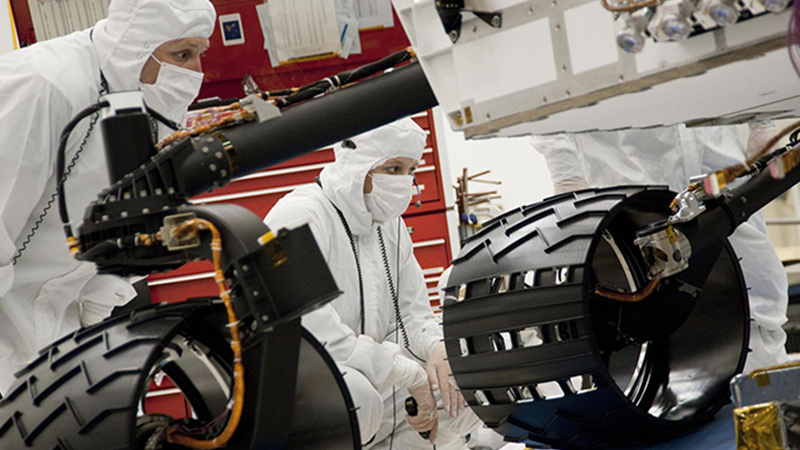See how these students got ahead with on-site experience
By Amanda Miller|November 20, 2017
Contending with skeptics of space travel while dressed up in an orange NASA onesie — and posting the performance on YouTube — lands a 21-year-old undergrad in Arkansas her summer job of “space disciple” to the leader of a Washington, D.C., federation.
Draping a blanket adorned with the presidential seal over a podium and delivering an address on why aerospace matters to the U.S. and world snags a student in Arizona her internship in Colorado, working on robotics and future space habitats.
From Georgia Tech to MIT, aerospace students are anxious to gain experience in the industry while they’re still in college.
“There definitely is a sense of urgency,” says Dawn Andrews, 21, an aerospace engineering major at Georgia Tech who interned at SpaceX in Hawthorne, California, last summer and continues with the company part time. “I feel almost behind by only having one internship experience.”
MIT aerospace engineering major Piper Sigrest, 21, reports a similar “strong drive among all students to get internships as soon as possible and get that experience.” She was an intern for SpaceX twice then at Virgin Orbit last summer.
These women were among the inaugural class of 36 participants selected under the Brooke Owens Fellowship Program, named for an accomplished space policy professional who died of cancer at age 35. In her short career, Owens worked for NASA, the nonprofit XPrize Foundation, the White House and the FAA. The program established in her memory matches female undergraduate students with summer internships at aerospace companies and nonprofits throughout the industry, while also pairing them with high-caliber mentors.
The selection process emphasizes creativity. Brooke Owens volunteers prescreen applicants and present host employers with a small selection of candidates who matched based on the student’s desire and the host organization’s needs. Hosts make the final selections. International students may apply, though certain employers will select only U.S. applicants.
With this year’s Dec. 5 deadline approaching, Aerospace America interviewed five inaugural Brooke Owens fellows for tips about applying, interviewing and ultimately landing an aerospace internship:
- Grow experience in the lab. Golda Nguyen’s research in Georgia Tech’s schools of psychology and aerospace engineering provided her with tangible experience on internship applications. Prior to being selected by Blue Origin for the Brooke Owens internship last summer, the now-21-year-old had completed internships at Pratt & Whitney and NASA (twice).
Andrews, the Georgia Tech student and former SpaceX intern, helped set herself up for that internship by conducting for-credit cubesat research on campus. “It’s a great way to get hands-on experience with missions that are going to space,” she says. - Join clubs to learn skills. Lab work and previous internships aren’t the only ways to make yourself attractive. Nguyen volunteered for the American Society of Mechanical Engineers and the Red Cross, where she gained experience with emailing and speaking professionally. Shreya Udupa, a 2017 aerospace engineering and economics graduate of Arizona State University, built water systems in Kenya as part of Engineers Without Borders. That experience helped her get selected by Altius Space Machines as a Brooke Owens fellow.
- Be bold. “Don’t let the fear of some screw-up prevent you from going full-out on something,” says Udupa, the perpetrator of the podium speech. Emily Sheffield, a mechanical engineering and prelaw major at Harding University in Arkansas, presented her hobbies and interests in infographic form for her Brooke Owens application. Along with the jumpsuit video, it contributed to her selection by the Commercial Spaceflight Federation.
- Get someone to look at your resume. “Ask for feedback from advisers and older mentors you can count on,” says Nguyen. She first sought internships by attending Georgia Tech’s career fairs, where a succinct resume was critical.
- Have a cheat sheet for interviews. With aerospace internships dating back to high school, MIT’s Sigrest has learned to have thoughtful responses to recurring questions ready to reference during interviews, such as projects she’s worked on or instances of practicing leadership.
- Just go for it. “Apply to any opportunity you think interests you, even if you’re afraid they’ll say no,” Sigrest says.
It’s a common refrain among the five fellows.
Nguyen got her first NASA internship by applying “on a whim — to see if anything would happen.”
Related Topics
EducationApplications for the Brooke Owens Fellowship Program are due Dec. 5. Go to www.brookeowensfellowship.org/apply/.






